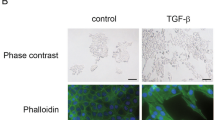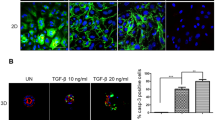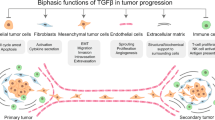Abstract
Transforming growth factor (TGF) β is a potent regulator of cell–matrix and cell-cell adhesions (collectively termed cellular adhesions). Cellular adhesions play crucial roles in controlling the differentiation of epithelial cells and in maintaining the integrity of the epithelium. Loss of TGF β-responsiveness is thought to be an important early initiating event in the malignant progression of epithelial cancer. In the TGFβ-responsive human colon adenocarcinoma Moser cells, TGFβ promotes cellular adhesions and suppresses their malignant phenotype. TGFβ promotes cell–matrix adhesion by inducing the synthesis of extracellular matrix (ECM) adhesion molecules and the expression of integrin receptors for these molecules (termed ECM remodeling). TGFβ promotes cell–cell adhesion through the induction of E-cadherin expression, an epithelial associated homotypic cell–cell adhesion molecule, which also functions as a tumor suppressor in colon cancer. How TGFβ regulates E-cadherin expression is not known. In this study, we showed that the induction of E-cadherin by TGFβ was mediated through the activation of focal adhesion kinase (FAK), a major signaling molecule in focal adhesion contacts and that the activation of FAK was due to ECM remodeling and increased cell–matrix interactions. Thus, TGFβ regulates cell–cell adhesion through its ability to remodel the ECM and to activate FAK through ECM remodeling.
This is a preview of subscription content, access via your institution
Access options
Subscribe to this journal
Receive 50 print issues and online access
$259.00 per year
only $5.18 per issue
Buy this article
- Purchase on SpringerLink
- Instant access to full article PDF
Prices may be subject to local taxes which are calculated during checkout



Similar content being viewed by others
References
Brattain MG, Levine LE, Chakrabarty S, Yeoman LC, Willson JKV and Long B . (1984). Cancer Met. Rev., 3, 177–191.
Brattain MG, Markowitz SD and Willson JK . (1996). Curr. Opin. Oncol., 8, 49–53.
Breen E, Steele G and Mercurio AM . (1995). Ann. Surg. Oncol., 2, 378–385.
Chakrabarty S . (1992). Int. J. Cancer, 50, 968–973.
Chakrabarty S and Huang S . (1995). J. Cell Physiol., 164, 148–153.
Chakrabarty S, Jan Y, Brattain MG, Tobon A and Varani J . (1989). Cancer Res., 49, 2112–2117.
Chakrabarty S, Rajagopal S and Moskal TL . (1998). Lab. Invest., 78, 413–421.
Chakrabarty S, Tobon A, Varani J and Brattain MG . (1988). Cancer Res., 48, 4059–4064.
Gumbiner BM . (1996). Cell, 84, 345–357.
Hanks SK and Polte TR . (1997). BioEssays, 19, 137–145.
Huang S and Chakrabarty S . (1994). Int. J. Cancer, 57, 742–746.
Ilyas M, Efstathiou JA, Straub J, Kim HC and Bodmer WF . (1999). Proc. Natl. Acad. Sci. USA, 96, 3087–3091.
Jacks T and Weinberg RA . (2002). Cell, 111, 923–925.
Lin CQ and Bissel MJ . (1993). FASEB J., 7, 737–741.
Lin TH, Aplin AE, Shen Y, Chen Q, Schaller M, Romer L, Aukhil I and Juliano RL . (1997). J. Cell Biol., 136, 1385–1395.
Markowitz S, Wang J, Myeroff L, Parsons R, Sun L, Lutterbaugh J, Fan RS, Zborowska, E, Kinzler KW, Vogelstein B, Brattain M and Willson JKV . (1995). Science, 268, 1336–1338.
Moses HL, Yang EY and Pietenpol JA . (1990). Cell, 63, 245–247.
Rajagopal S, Huang S, Albitar M and Chakrabarty S . (1997). J. Cell. Physiol., 170, 138–144.
Roskelley CD, Desprez PY and Bissell MJ . (1994). Proc. Natl. Acad. Sci. USA, 91, 12378–12382.
Schaller MD, Borgman CA, Cobb BS, Vines RI, Reynolds AB and Parsons JT . (1992). Proc. Natl. Acad. Sci.USA., 89, 5192–5196.
Shapiro L, Fannon AM, Kwong PD, Thompson A, Lehmann MS, Grubel G, Legrand J-F, Als-Nielsen J, Colman DR and Hendrickson WA . (1995). Nature, 374, 327–337.
Tang DG, Tarrien M, Dobrzynsk P and Honn KV . (1995). J. Cell. Physiol., 165, 291–306.
Thannickal VJ, Lee DY, White ES, Cui Z, Larios JM, Chacon R, Horowitz JC, Day RM and Thomas EJ . (2003). J. Biol. Chem., 278, 12384–12389.
Varallo VM, Gan BS, Seney S, Ross DC, Roth JH, Richards RS, McFarlane RM, Alman B and Howard JC . (2003). Oncogene, 22, 3680–3684.
Wang H and Chakrabarty S . (2001). J. Cell. Physiol., 187, 188–195.
Wary KK, Mariotti A, Zurzolo C and Giancotti FG . (1998). Cell, 94, 625–634.
Wrana JL, Attisano L, Wieser R, Ventura F and Massague J . (1994). Nature, 370, 341–346.
Acknowledgements
This study was supported by Public Health Service Grant R01CA47775.
Author information
Authors and Affiliations
Corresponding author
Rights and permissions
About this article
Cite this article
Wang, H., Radjendirane, V., Wary, K. et al. Transforming growth factor β regulates cell–cell adhesion through extracellular matrix remodeling and activation of focal adhesion kinase in human colon carcinoma Moser cells. Oncogene 23, 5558–5561 (2004). https://doi.org/10.1038/sj.onc.1207701
Received:
Revised:
Accepted:
Published:
Issue date:
DOI: https://doi.org/10.1038/sj.onc.1207701
Keywords
This article is cited by
-
A model for the dissemination of circulating tumour cell clusters involving platelet recruitment and a plastic switch between cooperative and individual behaviours
BMC Ecology and Evolution (2023)
-
Mesenchymal Stem Cells Induce Directional Migration of Invasive Breast Cancer Cells through TGF-β
Scientific Reports (2015)
-
Cell aggregation induces phosphorylation of PECAM-1 and Pyk2 and promotes tumor cell anchorage-independent growth
Molecular Cancer (2010)
-
TGFβ1 expression in colonic mucosa: modulation by dietary lipids
Genes & Nutrition (2007)
-
Transforming growth factor β signaling in colorectal cancer
Current Colorectal Cancer Reports (2007)



